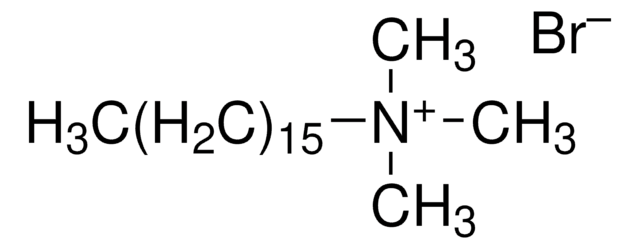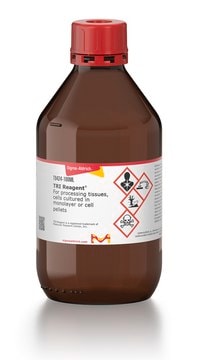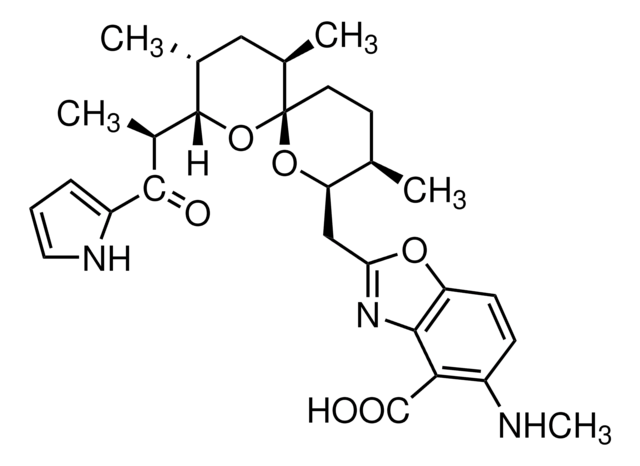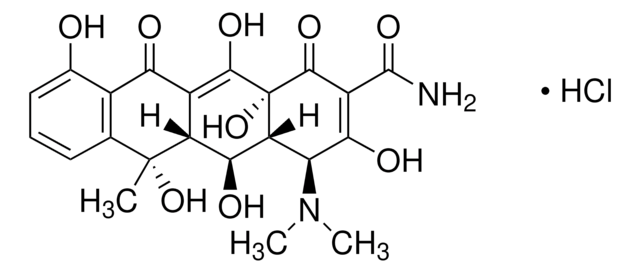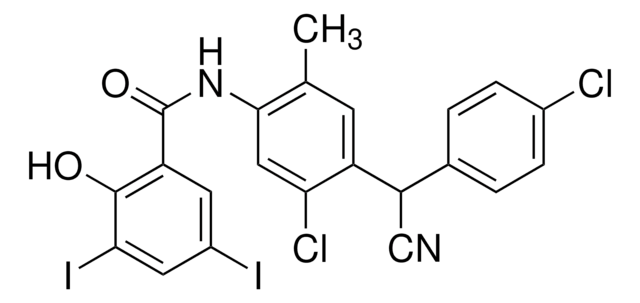R5628
Hae III from Haemophilus aegyptius
Restriction Enzyme
Iniciar sesiónpara Ver la Fijación de precios por contrato y de la organización
About This Item
Número de CAS:
MDL number:
UNSPSC Code:
12352204
Productos recomendados
grade
for molecular biology
form
buffered aqueous glycerol solution
concentration
10,000 units/mL
shipped in
wet ice
storage temp.
−20°C
¿Está buscando productos similares? Visita Guía de comparación de productos
Specificity
Recognition sequence: 5′-GG/CC-3′
Ligation and recutting results: After 2-10-fold Hae III overdigestion of 1 μg λ DNA substrate, results in 100% cutting, >50% of fragments can be ligated, and >95% recut.
Heat inactivation: 80 °C for 20 minutes.
Ligation and recutting results: After 2-10-fold Hae III overdigestion of 1 μg λ DNA substrate, results in 100% cutting, >50% of fragments can be ligated, and >95% recut.
Heat inactivation: 80 °C for 20 minutes.
Application
HaeIII is a restriction enzyme that is used in molecular biology methods to cleave DNA at the recognition site 5′-GG/CC-3′ to generate DNA fragments with blunt termini.
Other Notes
Supplied with 10x Restriction Enzyme Buffer SM (B3158).
Comment: Inefficient for single-stranded DNA cleavage.
Hae III requires optimal reaction conditions in order to avoid star activity.
Hae III requires optimal reaction conditions in order to avoid star activity.
Physical form
Solution in 20 mM Tris-HCl, pH 7.7, 0.1 mM EDTA, 400 mM NaCl, 10 mM 2-mercaptoethanol, 50% glycerol (v/v) at 4°C
Related product
Referencia del producto
Descripción
Precios
Storage Class
10 - Combustible liquids
wgk_germany
WGK 2
flash_point_f
Not applicable
flash_point_c
Not applicable
Certificados de análisis (COA)
Busque Certificados de análisis (COA) introduciendo el número de lote del producto. Los números de lote se encuentran en la etiqueta del producto después de las palabras «Lot» o «Batch»
¿Ya tiene este producto?
Encuentre la documentación para los productos que ha comprado recientemente en la Biblioteca de documentos.
Stefano Fazi et al.
Environmental microbiology, 10(10), 2760-2772 (2008-07-23)
We studied the diversity, community composition and activity of the primary microbial colonizers of the water above freshly re-wetted sediments from a temporary river. Dried sediments, collected from Mulargia River (Sardinia, Italy), were covered with sterile freshwater in triplicate microcosms
Duplex regions in "single-stranded" phiX174 DNA are cleaved by a restriction endonuclease from Haemophilus aegyptius.
R W Blakesley et al.
The Journal of biological chemistry, 252(20), 7300-7306 (1977-10-25)
Beatrix Kotlan et al.
Journal of immunology (Baltimore, Md. : 1950), 175(4), 2278-2285 (2005-08-06)
The potential tumor-recognizing capacity of B cells infiltrating human breast carcinoma is an important aspect of breast cancer biology. As an experimental system, we used human medullary breast carcinoma because of its heavy B lymphocytic infiltration paralleled to a relatively
C Kessler et al.
Gene, 92(1-2), 1-248 (1990-08-16)
The properties and sources of all known class-I, class-II and class-III restriction endonucleases (ENases) and DNA modification methyltransferases (MTases) are listed and newly subclassified according to their sequence specificity. In addition, the enzymes are distinguished in a novel manner according
Cong Zhu et al.
Nucleic acids research, 41(4), 2455-2465 (2013-01-11)
Zinc-finger nucleases (ZFNs) have been used for genome engineering in a wide variety of organisms; however, it remains challenging to design effective ZFNs for many genomic sequences using publicly available zinc-finger modules. This limitation is in part because of potential
Nuestro equipo de científicos tiene experiencia en todas las áreas de investigación: Ciencias de la vida, Ciencia de los materiales, Síntesis química, Cromatografía, Analítica y muchas otras.
Póngase en contacto con el Servicio técnico
